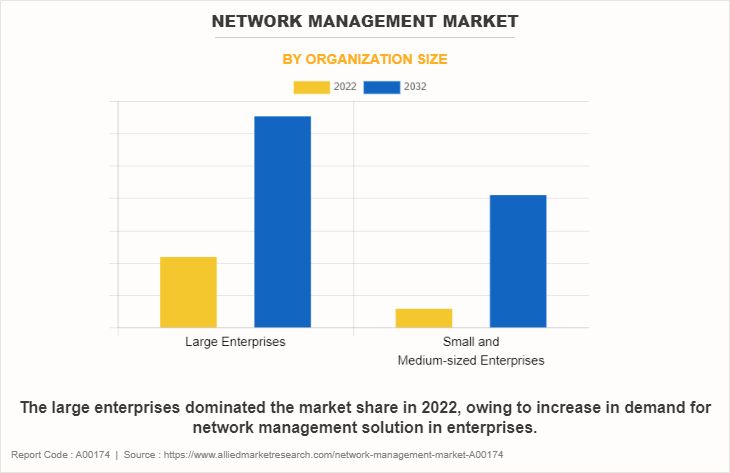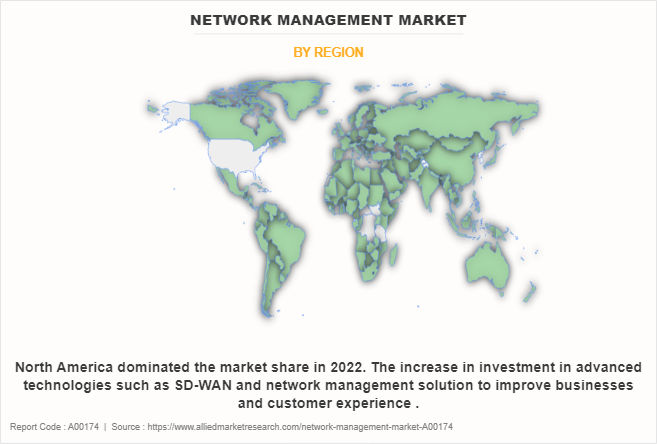Network Management Market Insight, 2032
The global network management market size was valued at $9.5 billion in 2022, and is projected to reach $25.3 billion by 2032, growing at a CAGR of 10.6% from 2023 to 2032.
Factors such as rise in digitalization and increase in adoption of advanced technologies such as IoT across the globe positively impact the growth of the market. For instance, in May 2023, IBM Corporation unveiled IBM Hybrid Cloud Mesh, a SaaS offering that is designed to enable enterprises to bring management to their hybrid multicloud infrastructure. In addition, the increase in adoption of network management solution across businesses to enhance operation & productivity is anticipated to propel the growth of the market in future.

Network management consists of applications, tools and processes used to provision, operate, maintain, administer, and secure network infrastructure. The overarching role of network management has ensured network resources are made available to users efficiently, effectively, and quickly. It leverages fault analysis and performance management to optimize network health.
Furthermore, an increase in investments by top players and a rise in demand for enhanced security solutions are expected to provide lucrative growth opportunities for market expansion during the forecast period. Moreover, the increase in adoption of emerging technologies such as 5G & edge computing and growth in demand for SD-WAN technology are anticipated to provide lucrative growth opportunities for the market in the upcoming years. However, network infrastructure complexity, security threats and costs budget are anticipated to hamper the network management market growth.
Segment Review
The network management market is segmented into component, deployment mode, network type, organization size, industry vertical, and region. On the basis of component, it is categorized into hardware, software and services. On the basis of network type, the market is divided into LAN, WAN and MAN. On the basis of deployment mode, it is bifurcated into on-premise and cloud. On the basis of organization size, the market is bifurcated into large enterprises, and small & medium-sized enterprises. On the basis of industry vertical, the market is classified into manufacturing, BFSI, retail, healthcare, IT & telecom and others. On the basis of region, the market is analyzed across North America, Europe, Asia-Pacific, and LAMEA.

On the basis of organization size, the global network management market share was dominated by the large enterprises segment in 2022 and is expected to maintain its dominance in the upcoming years, owing to demand for network management solution in enterprises. However, the SMEs segment is expected to witness the highest growth in the upcoming years. The adoption of advanced and cost-effective technologies such as 5G and IoT is expected to optimize the business capabilities of small & medium-sized enterprises.

Based on the region, North America dominated the market share in 2022 for the market. The increase in investment in advanced technologies such as SD-WAN and network management solution to improve businesses and the customer experience are anticipated to propel the growth of the market in this region. However, Asia-Pacific is expected to exhibit the highest growth rate during the forecast period. This is attributed to the increase in penetration of digitalization and higher adoption of IoT based devices. For instance, in October 2022, Nokia launched the cross-portfolio line up of Fixed Network solutions. The SaaS delivery model reduces IT dependencies, and with a usage-based subscription can deliver up to 25% lower cost of ownership.
Top Impacting Factors -
Growth in Hybrid Cloud Migration:
Organizations have embraced hybrid cloud migration as a strategic initiative to achieve a balance between security, flexibility, and scalability. Better visibility and control over the distributed network infrastructure has already resulted in the adoption of new technologies such as SD-WAN and network function virtualization (NFV). This migration has brought new skills to the networking table such as cloud infrastructure management, network automation, and orchestration. According to 2022 Global Hybrid Cloud Trends Report of Cisco, 82% of IT leaders have adopted the hybrid cloud, as hybrid clouds stay as long as the markets demand scalability, resilience, cost optimization, security, and streamlined IT operations.
Furthermore, many players have invested and exploring technologies through the partnership, product launch and acquisition to strengthen the market footprint. For instance, in February 2021, Italian software company Tanaza has partnered with Intelbras, the Brazilian manufacturer of telecoms and security products, to launch a cloud-managed networking platform for the Latam market. The platform allows remote configuration, monitoring, and troubleshooting in real-time of Intelbras-Tanaza powered devices deployed in multiple locations, from a single dashboard.
Rise in Demand for Digital Experience Monitoring (DEM):
Digital experience monitoring is another essential aspect of network management, as it provides greater visibility and control over both managed and unmanaged networks. The need for experience-driven network observability and management solutions is critical as businesses increasingly depend on digital services. DEM provides visibility into every communication path and degradation point, empowering teams to identify and resolve issues that could potentially impact the user experience delivery chain. This growth in need for user experience measurement and monitoring is expected to drive the adoption of DEM.
Regional Insights -
The network management market exhibits varied dynamics across regions, influenced by distinct economic and technological factors.
North America is a dominant market, characterized by high IT investment and advanced network infrastructure. The U.S. and Canada lead in adopting sophisticated network management solutions, driven by the need to support large-scale, complex networks and maintain high levels of operational efficiency such factors drive the market.
In Europe, the market benefits from significant investments in IT infrastructure and stringent data protection regulations like GDPR, which drive demand for robust network management tools. Western Europe, particularly, shows strong growth in sectors such as finance and telecommunications, where network reliability and compliance are critical.
The Asia-Pacific region is experiencing rapid growth due to accelerated urbanization and industrialization. Countries like China, India, and Japan are increasingly adopting advanced network management solutions to handle the rising complexity of their networks and address cybersecurity concerns.
Latin America is witnessing steady growth driven by the digital transformation of businesses and the increasing complexity of network environments. The expanding IT infrastructure across the region supports this upward trend. In the Middle East & Africa, investments in network management are on the rise, driven by expanding IT infrastructure and smart city initiatives. The market is growing as these regions enhance their technological capabilities and infrastructure development.
Competition Analysis
The market players operating in the market are Cisco Systems, Inc., IBM Corporation, Microsoft Corporation, juniper Networks, Inc., SolarWinds Corporation, Broadcom Inc., Huawei Technologies Co., Ltd., Hewlett Packard Enterprise, BMC Software, Inc. and Nokia Corporation. These major players have adopted various key development strategies such as business expansion, new product launches, and partnerships, which help to drive the growth of the network management market globally.
Recent Product Launch in the Market
October 2023, Huawei Technologies launched its latest Intelligent Cloud-Network products and solutions. The solution offers unmatched computing power and super-connectivity for AI-driven productivity in the intelligent era.
In July 2023, Juniper Networks, Inc., a leader in secure, AI-driven networks, launched the new EX4100 series of enterprise-grade wired access switches, which leverage a modern microservices cloud and Mist AI to deliver outstanding performance, ease, flexibility and security for all enterprise access layer switching environments, including campus fabric architectures.
In June 2022, Cisco has announced two new products that mark a shift in its approach to network management that will shape the company's portfolio for the coming years.
Recent Partnership in the Market
In May 2023, NTT Ltd., a leading IT infrastructure and services company partnered with Cisco, a global leader in technology, to develop and deploy joint solutions that empower organizations to improve operational efficiencies and advance sustainability goals.
Key Benefits for Stakeholders
- The study provides an in-depth network management market overview along with the current trends and future estimations to elucidate the imminent investment pockets.
- Information about key drivers, restrains, and opportunities and their impact analysis on the network management market size is provided in the report.
- The Porter’s five forces analysis illustrates the potency of buyers and suppliers operating in the network management industry.
- The quantitative analysis of the global market for the period 2022–2032 is provided to determine the network management market potential.
Network Management Market Report Highlights
| Aspects | Details |
| Market Size By 2032 | USD 25.3 billion |
| Growth Rate | CAGR of 10.6% |
| Forecast period | 2022 - 2032 |
| Report Pages | 285 |
| By Organization Size |
|
| By Industry Vertical |
|
| By Component |
|
| By Deployment Mode |
|
| By Network Type |
|
| By Region |
|
| Key Market Players | Microsoft Corporation, IBM Corporation, Broadcom, Inc., Cisco Systems, Inc., Nokia Corporation, Hewlett Packard Enterprise (HPE), Huawei Technologies Co., Ltd., SolarWinds Corporation, BMC Software, Juniper Networks, Inc. |
Analyst Review
Over time, businesses have seen various changes in the business processes, operations, and industrial automation. Network management technology has become a necessity as more businesses become reliant on internet connectivity for business-critical and cloud applications. Network security is expected to be a top priority as customers add more connections to their enterprises, and as applications move toward a multi-cloud environment. Customers need to protect against the evolving cyber threat landscape as they want their business assets to always be available and secure. Businesses in the industry have expanded investments in all aspects of network security to create effective cybersecurity architectures.
Furthermore, service providers such as Nokia, Cisco and other key players have began to offer more solutions to enhance the market growth during the forecast period. For instance, in October 2023, Broadcom Inc. introduced the DX NetOps 23.3 and AppNeta. It assures end-to-end observability, minimizing the visibility gaps beyond the network borders to Cloud, SaaS, and Sites. The solution provides a unique and industry-leading unified network management approach, allowing organizations to optimize network operations, accelerate transformation and enhance connected experiences.
Moreover, prominent market players explore new technologies and devices to meet the increase in customer demands. Product launches, collaborations, and acquisitions are expected to enable them to expand their product portfolios and penetrate different regions. Emerging economies provide lucrative opportunities to market players for growth or expansion. For instance, in April 25, 2023, Hewlett Packard Enterprise introduced product innovations to help enterprise IT teams simplify network management processes and improve operational agility with the next generation of HPE Aruba Networking Central, a cloud-native network management solution. In addition, HPE Aruba Networking also announced Network-as-a-service (NaaS) capabilities for customers and channel partners to acquire, deploy, and manage on the HPE GreenLake platform with a monthly subscription. Such enhancements are expected to provide lucrative opportunities for the market growth during the forecast period.
The North America is the largest market for the Network Management.
Factors such as rise in digitalization and increase in adoption of advanced technologies such as IoT across the globe positively impact the growth of the market.
The key growth strategies for Network Management Market include product portfolio expansion, acquisition, partnership, merger, and other.
Network Management Market is expected to reach $25253.59 Million, by 2032.
The market players operating in the network management market are Cisco Systems, Inc., IBM Corporation, Microsoft Corporation, juniper Networks, Inc., SolarWinds Corporation, Broadcom Inc., Huawei Technologies Co., Ltd., Hewlett Packard Enterprise, BMC Software, Inc. and Nokia Corporation.
Loading Table Of Content...
Loading Research Methodology...


